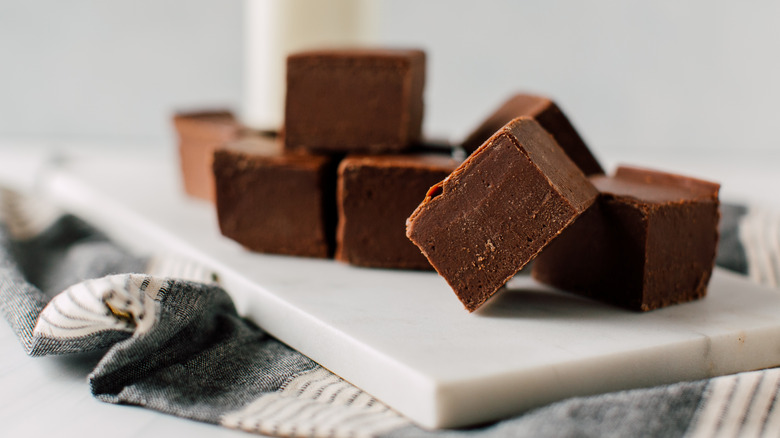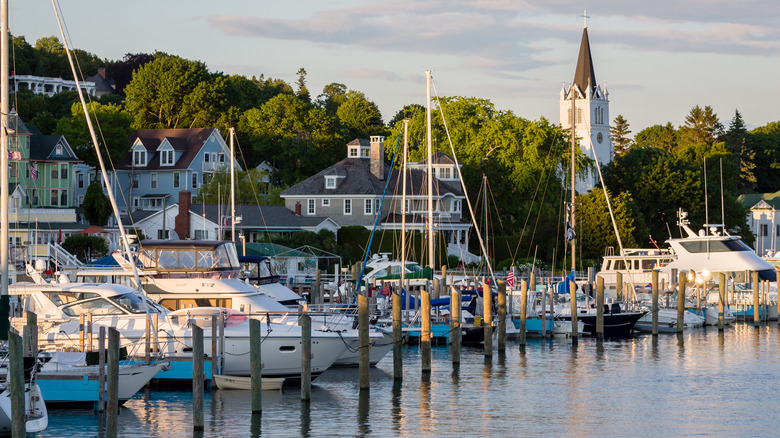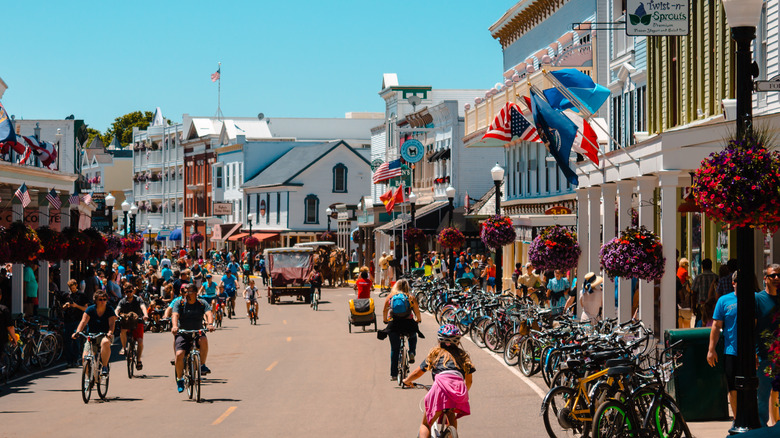The Tiny US Island Known As The 'Fudge Capital Of The World'
Team Sweet Tooth is dominating the gastronomic universe. According to a study published in Advances in Nutrition, 25% of U.S. adults enjoy candy every day, and nearly everybody (97%) has a sweet at least once a year. It would be impossible to dive into the world of sweets without mentioning fudge. June 16 is National Fudge Day. Every August holds the Mackinac Island Fudge Festival, complete with a Fudge-Olympics, and something called "Fudge Quest." In case you haven't heard of it before, introducing Mackinac Island: the tiny U.S. island known as the "fudge capital of the world."
Mackinac Island is revered as a National Historic Landmark, and it's nestled between Michigan's upper and lower peninsulas, per news outlet WIS 10. The entire island spans only 3.8 square miles and 80% of that is dedicated to Mackinac Island State Park. The other 20%, we assume, is dedicated to cranking out world-famous fudge, which Mackinac has been doing since the 1880s. Today, there are currently seven fudge shops on the island, which means you're never more than a half mile away from at least one purveyor. In his book "Fudge: Mackinac's Sweet Souvenir," Phil Porter explains that the island used to be a fur-trading hub, but shifted toward a summertime destination for wealthy vacationers during the Victorian era. While on holiday at Mackinac, they enjoyed maple sugar, then later fudge, and the rest is (literally) history. So, what's all the hype about? And what makes Mackinac so special?
A sweet history
Fudge has been interwoven into the Mackinac visitors' experience for centuries. Confectioner Harry Ryba (lauded as the "Fudge King of Mackinac Island" by The New York Times) once offered to sell folks a lifetime supply of fudge (three pounds a month) for $2,250, says Mental Floss. But before that, Rome Murdick opened the first candy shop on Mackinac during the 1880s. Murdick turned fudge-making into a public spectacle by making slabs right in front of customers, funneling vanilla into fudge cauldrons, and even blowing the enticing aroma out into the street with kitchen fans.
The Benser family took over Murdick's operation during the 1960s, per WIS 10, but still remains faithful to Murdick's original fudge-making process and recipes. The fudge is heated in a copper kettle and then rolled across a large marble countertop to cool. It's a hands-on process through and through, but that might be part of what has earned Mackinac Island its global confectionery fame. In fact, Mackinac fudge's popularity has only increased over the years.
Fudge fans flock to Mackinac
Mackinac Island doesn't allow cars (yes, really) and hasn't for over a century. So, roughly 600 horses and 1,489 rentable bicycles get folks from Point A to Point B across the island. But the lack of cars doesn't seem to be slowing fudge fans down at all. Last year, the Detroit Free Press reported that Mackinac Island saw record-high tourism revenue, with an estimated 650,000 visitors during the summer of 2021. Ferry boat driver Chris Shepler told the outlet, "This summer was out of control, off the charts crazy." Fudge shop sales saw an 18% increase from the previous season, says Mackinac restaurateur Todd Callewaert — so there's probably a good chance that many visitors come just for the fudge.
According to Mackinac Island's website, a whopping 10 tons of sugar are imported to the island each week in peak fudge season. During this time, the small island churns out 10,000 pounds of fudge every single day. Considering three eight-ounce slabs of fudge from the Original Mackinac Island Fudge Co. run $29.95 before shipping, that comes out to roughly $200,000 worth of fudge produced every day.


